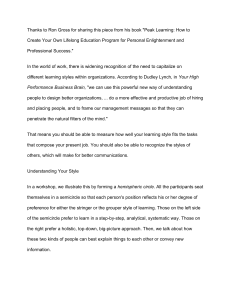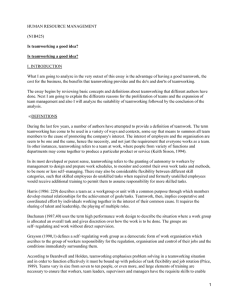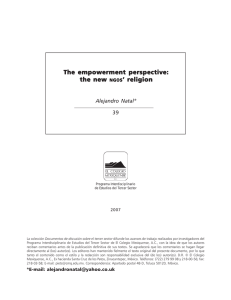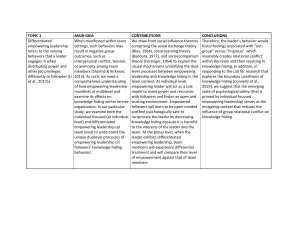Leadership
Anuncio
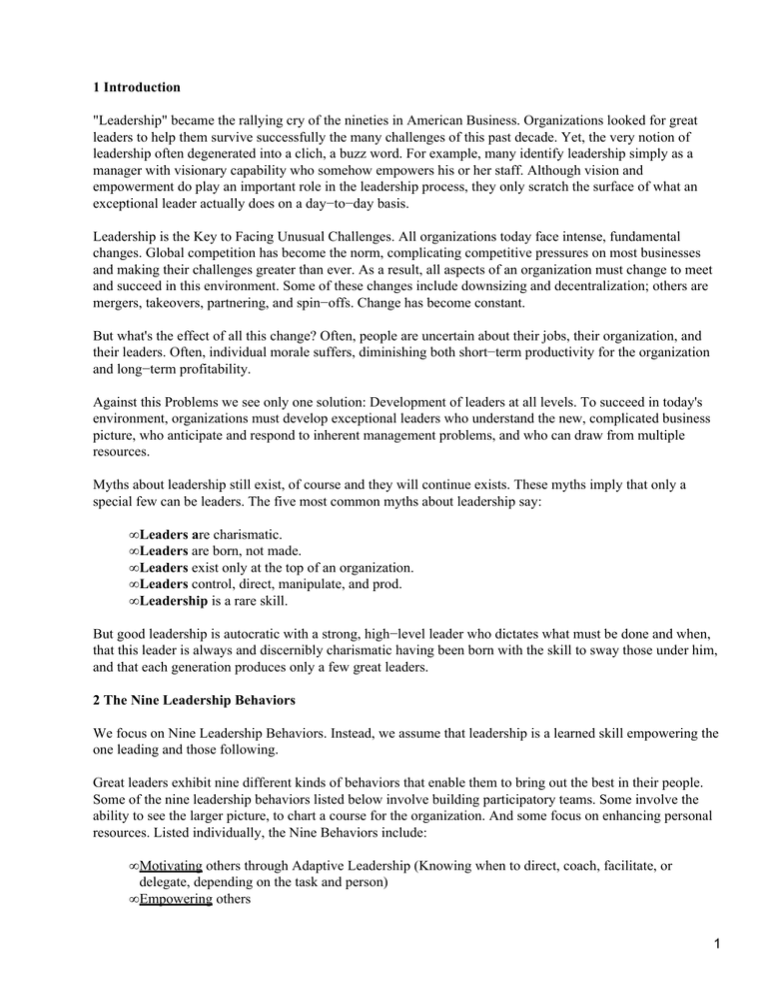
1 Introduction "Leadership" became the rallying cry of the nineties in American Business. Organizations looked for great leaders to help them survive successfully the many challenges of this past decade. Yet, the very notion of leadership often degenerated into a clich, a buzz word. For example, many identify leadership simply as a manager with visionary capability who somehow empowers his or her staff. Although vision and empowerment do play an important role in the leadership process, they only scratch the surface of what an exceptional leader actually does on a day−to−day basis. Leadership is the Key to Facing Unusual Challenges. All organizations today face intense, fundamental changes. Global competition has become the norm, complicating competitive pressures on most businesses and making their challenges greater than ever. As a result, all aspects of an organization must change to meet and succeed in this environment. Some of these changes include downsizing and decentralization; others are mergers, takeovers, partnering, and spin−offs. Change has become constant. But what's the effect of all this change? Often, people are uncertain about their jobs, their organization, and their leaders. Often, individual morale suffers, diminishing both short−term productivity for the organization and long−term profitability. Against this Problems we see only one solution: Development of leaders at all levels. To succeed in today's environment, organizations must develop exceptional leaders who understand the new, complicated business picture, who anticipate and respond to inherent management problems, and who can draw from multiple resources. Myths about leadership still exist, of course and they will continue exists. These myths imply that only a special few can be leaders. The five most common myths about leadership say: • Leaders are charismatic. • Leaders are born, not made. • Leaders exist only at the top of an organization. • Leaders control, direct, manipulate, and prod. • Leadership is a rare skill. But good leadership is autocratic with a strong, high−level leader who dictates what must be done and when, that this leader is always and discernibly charismatic having been born with the skill to sway those under him, and that each generation produces only a few great leaders. 2 The Nine Leadership Behaviors We focus on Nine Leadership Behaviors. Instead, we assume that leadership is a learned skill empowering the one leading and those following. Great leaders exhibit nine different kinds of behaviors that enable them to bring out the best in their people. Some of the nine leadership behaviors listed below involve building participatory teams. Some involve the ability to see the larger picture, to chart a course for the organization. And some focus on enhancing personal resources. Listed individually, the Nine Behaviors include: • Motivating others through Adaptive Leadership (Knowing when to direct, coach, facilitate, or delegate, depending on the task and person) • Empowering others 1 • Encouraging teamwork (Balancing results, process, and relationships • Preparing people for change (Understanding their psychological responses and helping them create positive change with force−field analysis) • Having a strong, clear vision • Using multiple options thinking (Seeing different strategic possibilities and being open to more day−to−day options) • Taking intelligent risks (Relating decision−making to risks, getting consensus) • Stretching one's personal creativity (Renewing personal resources) Being passionate about work (Demonstrating presence, inspiration The first four behaviors focus on building high functioning teams: motivating and empowering others, encouraging teamwork, and preparing people for change. Motivating Others Good leaders have a strong interest in the personal and professional development of their people. They encourage their staff to push beyond their limitations and give their personal best. One of the best ways to get this notion of encouragement and support across to people is to ask participants to remember and then write down how their best boss treated them, and how they felt about it. Then, have them share their answers with the rest of the group. Point out the common denominators in their answers so that their own experiences flesh out a composite picture of what it is like to offer people the support they need. Finally, ask them this: If their own people were to do a similar exercise, would their own names be on their people's lists? If not, why not? Where are they falling short in evoking the best from their people? Equally important is developing ways to tap into internal motivation by taking the appropriate leadership actions that stimulate the greatest job growth in each person. One way to develop that behaviour is to analyse each business task and the staff who are performing it. Sometimes, a leader can delegate the work without supervision, but more often leaders need to coach, to facilitate or to direct so that the task is accomplished well and the worker learns eventually how to become more independent. Group exercises help participants experience these different levels of situational management. Empowering Others Empowerment involves four dynamics: giving people important work to do; offering visibility and public recognition; encouraging autonomy; and helping them to establish networking skills.(IVAN) Exercises help participants feel the importance of each of the four dynamics. Encouraging Teamwork A good leader not only develops his or her people as individuals but also knows how to get the best out of people when they work on teams. Being able to handle the subtle dynamics of a whole group of people is not equivalent to dealing with the sum of its parts. By breaking participants into small groups and giving them a simple problem to solve, you can teach them about the issues that arise for teams. For example, if they work in small, separate teams on a tower building project, they will see how working together in one team accomplishes a greater product. Or, if they each have a specific task that is necessary to get the job done − being thenavigator or pilot or other crew while landing the space shuttle back on earth − they see the necessity of functioning well together. Some groups are results oriented. Some work on process, while others focus more on the relationships among the team members. Analysing these three aspects of teamwork helps participants think about the way they 2 work best individually and in teams. Preparing People for Change In the work place, change is pervasive. The companies that succeed prepare their people for change so that they understand how it can be used as an opportunity. Recognizing the four stages of psychological response to change: denial, resistance, adaptation, and commitment is crucial for a leader as he or she opens up communication and possibilities for the future. And using tools such as the Force−Field Exercise help people see how to make change work for them, wrapping in motivation, empowerment, and teamwork as people learn to recognize driving forces of positive change as well as resistance to it. Motivating empowering, encouraging, and preparing for change are four ways for a leader to get honest support. The best method to accomplish all these characteristics is to be a role model of an intelligent, caring person who truly listens. But leaders also have to lead. They are expected to have a vision and to know problem situations and how to handle them appropriately. Using multiple options thinking and intelligent risk−taking are two ways to move beyond traditional management techniques that focus on single solutions and avoidance of any risk. Articulating Vision and Mission Having a clear sense of vision is important. But equally important is the ability to articulate it so that others get excited about the future direction and want to contribute to it as part of their mission. Multiple Options Thinking Exceptional leaders don't stop at the obvious. They know that the first answer they get may not always be the best answer, and even the "right" answer may not be appropriate for a particular situation. There are two kinds of multiple options thinking for the long−term strategies and for the short−term task. Scenario planning helps leaders envision different possible futures and plan for any one of them. And habitually considering at least four options for any given situation, helps develop the skill of searching for new solutions rather than going with the familiar, single way of past performance. Intelligent Risk Taking Good leaders know how to analyse the risks inherent in a particular course of action. They know when an action is high−risk or low−risk. Even more importantly, they know how to gain consensus from their staff about the level of risk for particular actions, so that their people do not treat high−risk activities as low−risk or vice versa. Stretching One's Personal Creativity When a leader is able to stretch personal creativity continually, it pulls together all the other behaviours. We sense that exceptional leaders are always learning something new. They are willing to stretch out into new arenas and discover things they didn't know before. Passion for the Work The leader's ability to inspire and project into the future helps others feel worthwhile in their own work and have a sense of purpose. Most important is the combination of words that work with actions so that others trust the vision and feel confident about its possibility. Small group exercises, including videotaping, help develop these concepts experientially 3 3 Styles of leadership In the past several decades, management experts have undergone a revolution in how they define leadership and what their attitudes are toward it. They have gone from a very classical autocratic approach to a very creative, participative approach. Somewhere along the line, it was determined that not everything old was bad and not everything new was good. Rather, different styles were needed for different situations and each leader needed to know when to exhibit a particular approach. But four of the most basic leadership styles are: • Autocratic • Bureaucratic • Laissez−faire • Democratic Autocratic Leadership Style This is often considered the classical approach. It is one in which the manager retains as much power and decision−making authority as possible. The manager does not consult employees, nor are they allowed to give any input. Employees are expected to obey orders without receiving any explanations where it's created a structured of rewards and punishments to motivate the people. This leadership style has been greatly criticized during the past 30 years. Some studies say that organizations with many autocratic leaders have higher turnover and absenteeism than other organizations and these studies criticizes that autocratic leaders rely on threats and punishment to influence employees, do not trust employees, do not allow for employee input. Bureaucratic Leadership Style Bureaucratic leadership is where the manager manages by the book¨. Everything must be done according to procedure or policy. If the book doesn't cover it, the manager refers to the next level above him or her. This manager is really more of a police officer than a leader. He or she enforces the rules. Democratic Leadership Style The democratic leadership style is also called the participative style as it encourages employees to be a part of the decision making. The democratic manager keeps his or her employees informed about everything that affects their work and shares decision making and problem solving responsibilities. This style requires the leader to be a coach who has the final say, but gathers information from staff members before making a decision. Democratic leadership can produce high quality and high quantity work for long periods of time. Many employees like the trust they receive and respond with cooperation, team spirit, and high morale. Laissez−Faire Leadership Style The laissez−faire leadership style is also known as the hands−off¨ style. It is one in which the manager provides little or no direction and gives employees as much freedom as possible. All authority or power is given to the employees and they must determine goals, make decisions, and resolve problems on their own. The connective leadership 4 A more complex view can be considering connective leadership, as that of Anita Roddick from the Body Shop. This is related to the strategy she follows in her global enterprise: employes and customers alike are drawn into her controversial crusades; both the leader, the staff and trainees and customers are together committed to the aims of the leader (becoming thus the aims of the company): protecting the rain forests, saving the whales, aiding Third World and tribal nations, helping the homeless etc. These common issues create interdependence and encourage diversity into the company. Following connective leadership, as summed up in the following image, may mean following the latin motto tribuere unicuique suum, that is: trying to separate the roles of the people giving them the freedom to arrange their contribution to the company's and the leaders' aims, according to their own leadership styles. So the chairman of the company is simply defining the objectives and connecting the different motivations and attitudes of the employees. 4 Leadership Types in Organizations • − Transactional leadership • − Transformational leadership • − Superleadership / Self−leadership /empowerment • − Mentoring or organizational socialization guided by a mentor • − Coaching or development by means of the training Considering the diversity of people who exert like leaders in an organization and the variables, which they influence in efficacy, and going beyond the behaviours, which they suppose the different styles from leadership, the perspective can be extended to consider some types or general approaches of leadership of great relevance for the operation of individuals, groups and organizations. Transactional Leadership It means and talks about the habitual interchange that takes place between leaders and collaborator in the daily and stable situations of the daily work. It usually goes associated to the intermediate directive levels and with more reduced scopes of responsibility, frequently oriented to direct a team, a department or a functional unit of the organization. In this interchange the direct relations, face to face, used to predominate. It is based on the agreement between both parts about the objectives, as well as the conditions and compensations that they will receive to reach them. The transformational leadership It's an expansion of the transactional leadership. It usually is bound to change or crisis situations in the organization. And although that situation didn't exist, this type is always entailed with a shade of overcoming of the routine that is pronounced in the leader with the following behaviours like maintaining present the equipment vision and mission, establishing expectations that suppose challenges and a greater yield, stimulating to the others to use different perspective in their works, facilitating the maximum development of all its potential to reach profits higher than they believed possible and motivating to them to integrate its own interests with the team and the organization interests. Although this type of leadership can be exerted in all the directive levels, tends to go associated with the most elevated positions of the organization. Besides face to face, also the half−full interactions (indirect) between the leader and the others have capacity in this type of leadership. Superleadership/ Self−Leadership/ Empowerment 5 Empowerment goes beyond the Transformational Leadership. It doesn't try only to harness to the maximum the capacities of the followers, but to turn them into their own leaders (Self−leadership), in such a way that they acquire the responsibility to motivate themselves and to direct their own behaviours; in other words, the superleader teaches to others to go to themselves. The steps that must follow a leader to become superleader are: To become autolíder, to exert of self−leadership model to try their collaborators learn from him, to animate to them to that they establish his own goals, to reward their self−leadership behviours, to create a self−leadership culture, and to foment the work in equipment to promote self−leadership. Mentoring or organizational socialization guided by a mentor It's a process that starts within the organization with the purpose of facilitating the socialization and progress of a worker who has just incorporated or is in a while of transit towards other positions (normally the more elevated in the hierarchy). The main figures in all this process are the mentor ("leader") and the apprentice or aspiring ("collaborating"). Coaching Term extracted and adapted of the sport scope to describe the facet of the leader like a " trainer " who selects and develops the competitions of his collaborators, who guide them, adviser, supports and stimulates. It could be a part of mentoring, (not necessarily) and it's developed with a narrow relation, face to face between the "trainer" and "trained". 5 Conclusion The Nine Behaviors of Leadership past assumptions about management in American businesses and corporations−−that it be autocratic, with a strong high−level leader who dictates what must be done and when. Even though participatory leadership has been espoused by management theorists for years, many organizations still define leadership as a single, charismatic executive who happened to be born with rhetorical skills, management know−how, a tough hide, and the ability to push others to extremes. Academic theory versus management reality is the justification for ignoring a different kind of leadership. We challenge this "pragmatic reality" view because the focus tends to be on driving short term results which, more often than not, obliterate long−term success and sustain ability. And as long as these kinds of leadership myths persist, real leadership development cannot take place. We feel that leadership is actually much more complex, that it should exist at different levels within an organization, and that participatory leadership should be woven into the fabric of a company. Participatory leadership taps into the vast potential of every employee, catalyzing personal and professional growth and creates a culture of organizational success. Rather than driving hard for immediate results, participatory leadership is a model that looks to future sustain ability by balancing the need for results with understanding the process and paying attention to relationships. And best of all, this leadership can be learned as one challenges current assumptions, changes behavioral patterns, and implements new action plans Leadership is not a mysterious process. It can be clearly defined and its component parts can be taught to your people. 6. Bibliography − references: 6 The connective edge, leading in an interdependent world Lipman, Blumen. Jossey−Bass Publishers, San Francisco (1996) Articles and stencils from the course Leadership and Culture Styles of Leadership − Report 1 08/03/2002 Group 6 7

